.

When medics cry, you must understand that there are catastrophes happening: photo by Rami N. AbuShabaan, 25 July 2014
Israel’s vision of itself was once
As a “light unto the nations”.
It has no need of the fearful hatred,
Fuelling its bombs and its bullets,
Unless it wishes to fade away --
Putting out the light that might enable it
To see the stranger as a friend.
Heathcote Williams: from An Old Man and a Young Man in Gaza, July 2014

The WORST experience in my life was: to tell a mother looking for her children that they are all DEAD: photo by Dr. Bassel Abuwarda, 25 July 2014

This is the massacre in Al Naggar Family. I am sorry for pictures: photo by Dr. Saeed Kanafany, 25 July 2014

The massacre in Al Naggar Family. I am sorry for pictures: photo by Dr. Saeed Kanafany, 25 July 2014

The massacre in Al Naggar Family. I am sorry for pictures: photo by Dr. Saeed Kanafany, 25 July 2014

The massacre in Al Naggar Family. I am sorry for pictures: photo by Dr. Saeed Kanafany, 25 July 2014
Artillery Corps in Gaza. IDF artillery forces fire into the Gaza Strip as part of Operation Protective Edge: photo by Israel Defense Forces, 24 July 2014

Artillery Corps in Gaza. IDF artillery forces fire into the Gaza Strip as part of Operation Protective Edge: photo by Israel Defense Forces, 24 July 2014

Al Naggar Family Massacre. Numbers increasing: photo by Dr. Saeed Kanafany, 25 July 2014

Al Naggar Family Massacre. Numbers increasing: photo by Dr. Saeed Kanafany, 25 July 2014

Al Naggar Family Massacre. Numbers increasing: photo by Dr. Saeed Kanafany, 25 July 2014

WHY SHOULD OUR CHILDREN BEG FOR LIFE!!!: photo by Dr. Bassel Abuwarda, 25 July 2014

Miracle in Gaza: Israel killed her mother before she could give birth, but heroic doctors managed to rescue her!: photo via Dima Eleiwa, 25 July
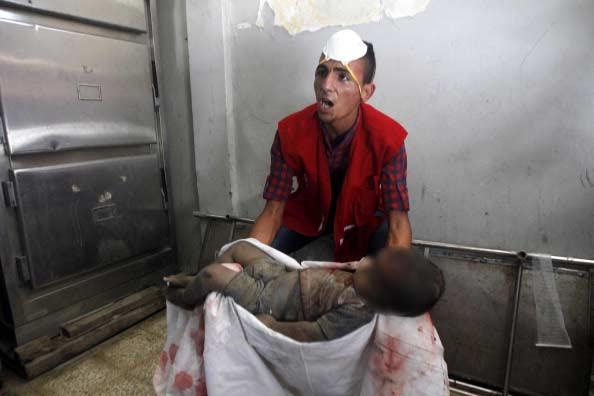
More Palestinian "terrorists" targeted by Israeli "self defence": photo by Haitham Sabbah, 26 July 2014
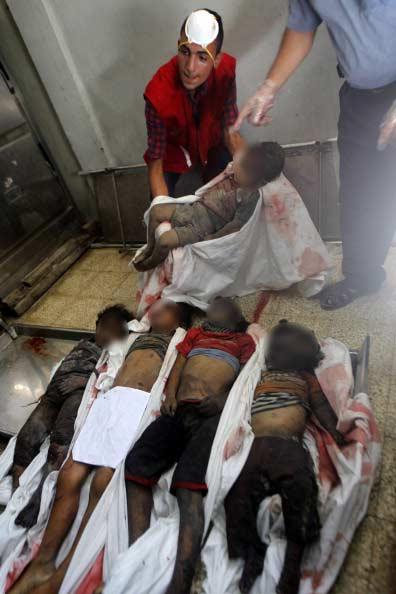
More Palestinian "terrorists" targeted by Israeli "self defence": photo by Haitham Sabbah, 26 July 2014

A father and a little girl in their last moments. Who will seek justice for him?: photo by Mina, 24 July 2014


A father and a little girl in their last moments. Who will seek justice for him?: photo by Mina, 24 July 2014

As a “light unto the nations”.
It has no need of the fearful hatred,
Fuelling its bombs and its bullets,
Unless it wishes to fade away --
Putting out the light that might enable it
To see the stranger as a friend.
Heathcote Williams: from An Old Man and a Young Man in Gaza, July 2014

The WORST experience in my life was: to tell a mother looking for her children that they are all DEAD: photo by Dr. Bassel Abuwarda, 25 July 2014
Numbers increasing
13 martyrs Al Naggar family
Massacres everywhere
-- Dr Saeed Kanafany, surgeon, via Twitter from Gaza, 26 July 2014
13 martyrs Al Naggar family
Massacres everywhere
-- Dr Saeed Kanafany, surgeon, via Twitter from Gaza, 26 July 2014

This is the massacre in Al Naggar Family. I am sorry for pictures: photo by Dr. Saeed Kanafany, 25 July 2014

The massacre in Al Naggar Family. I am sorry for pictures: photo by Dr. Saeed Kanafany, 25 July 2014

The massacre in Al Naggar Family. I am sorry for pictures: photo by Dr. Saeed Kanafany, 25 July 2014

The massacre in Al Naggar Family. I am sorry for pictures: photo by Dr. Saeed Kanafany, 25 July 2014
Artillery Corps in Gaza. IDF artillery forces fire into the Gaza Strip as part of Operation Protective Edge: photo by Israel Defense Forces, 24 July 2014

Artillery Corps in Gaza. IDF artillery forces fire into the Gaza Strip as part of Operation Protective Edge: photo by Israel Defense Forces, 24 July 2014

Al Naggar Family Massacre. Numbers increasing: photo by Dr. Saeed Kanafany, 25 July 2014

Al Naggar Family Massacre. Numbers increasing: photo by Dr. Saeed Kanafany, 25 July 2014

Al Naggar Family Massacre. Numbers increasing: photo by Dr. Saeed Kanafany, 25 July 2014

WHY SHOULD OUR CHILDREN BEG FOR LIFE!!!: photo by Dr. Bassel Abuwarda, 25 July 2014

Miracle in Gaza: Israel killed her mother before she could give birth, but heroic doctors managed to rescue her!: photo via Dima Eleiwa, 25 July

More Palestinian "terrorists" targeted by Israeli "self defence": photo by Haitham Sabbah, 26 July 2014

More Palestinian "terrorists" targeted by Israeli "self defence": photo by Haitham Sabbah, 26 July 2014

A father and a little girl in their last moments. Who will seek justice for him?: photo by Mina, 24 July 2014

\A father and a little girl in their last moments. Who will seek justice for him?: photo by Mina, 24 July 2014

A father and a little girl in their last moments. Who will seek justice for him?: photo by Mina, 24 July 2014

A father and a little girl in their last moments. Who will seek justice for him?: photo by Mina, 24 July 2014
Artillery Corps in Gaza. IDF artillery forces fire into the Gaza Strip as part of Operation Protective Edge: photo by Israel Defense Forces, 24 July 2014
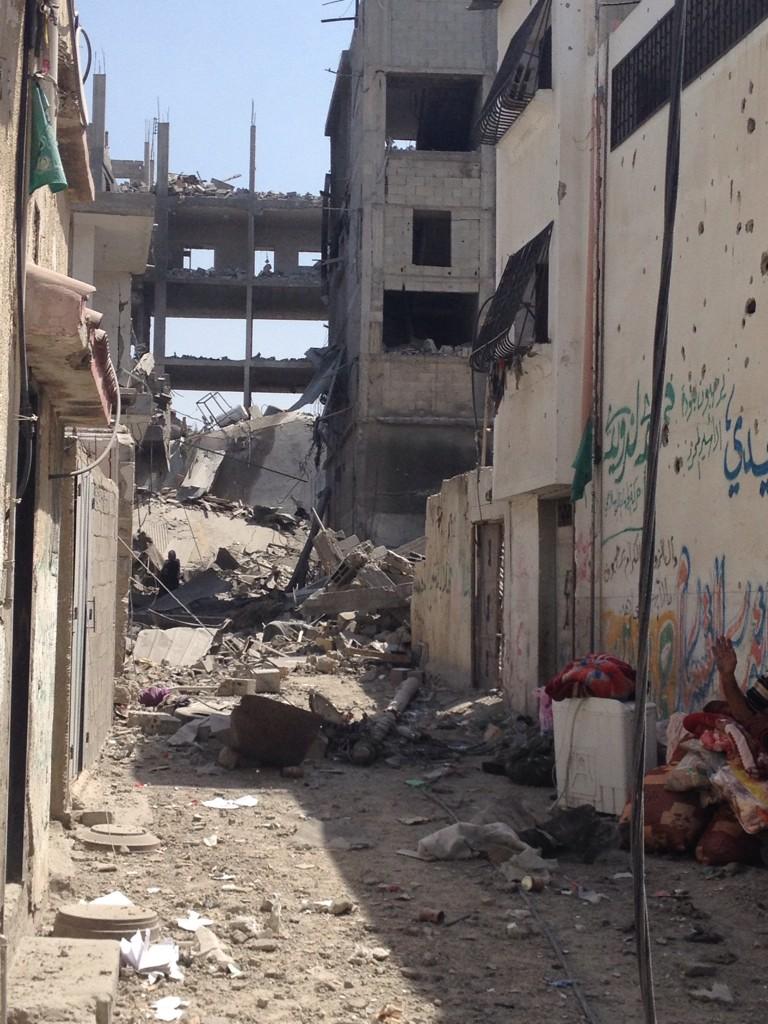
Heartbreaking in Beit Hanoun northern Gaza, massive destruction: photo by Hazem Balousha, 26 July 2014
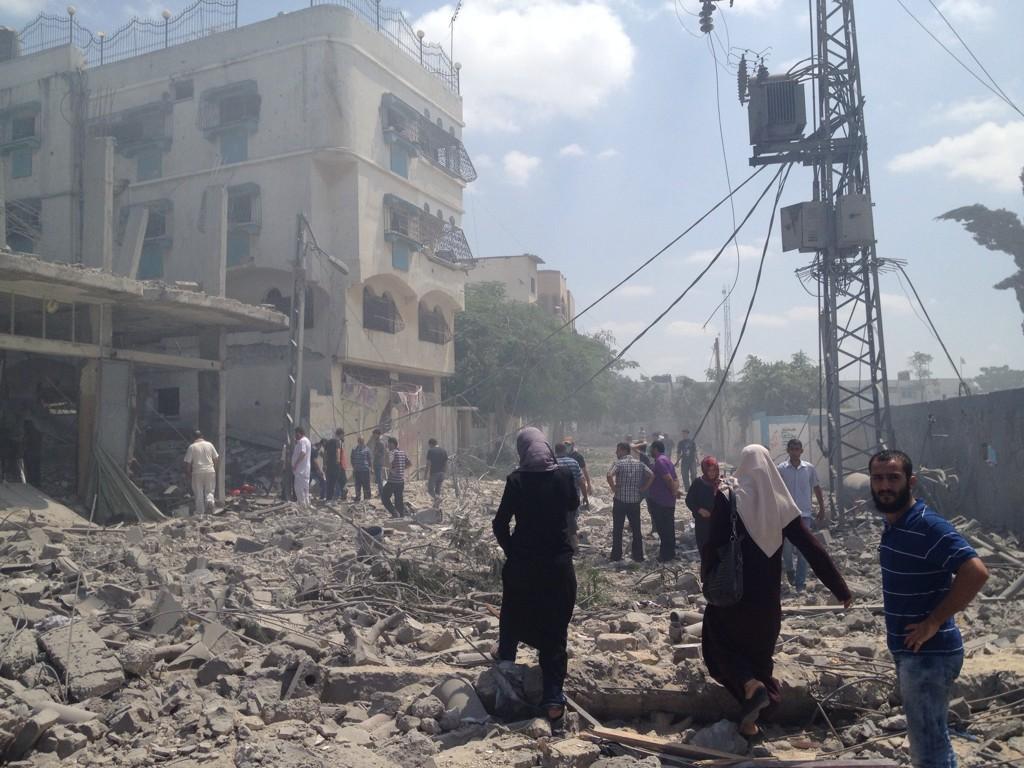
Heartbreaking in Beit Hanoun northern Gaza, massive destruction: photo by Hazem Balousha, 26 July 2014
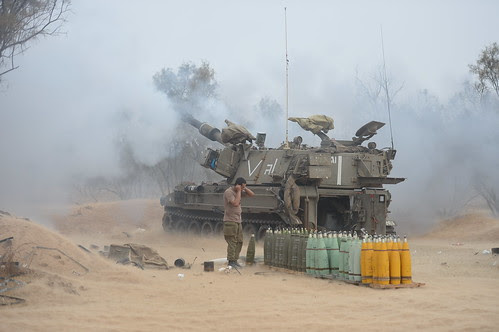




9 comments:
As of yesterday, three Israeli civilians have been reported killed by Hamas rocket fire in the current conflict. There is an effective graphic capturing the proportionality of the Israeli 'response', as measured in deaths, here:
http://www.washingtonpost.com/wp-srv/special/world/gaza-counter/
I can look at undamaged stick figures on a graphic, but not any more at these unbearable photographs. My weakness - keep up the indispensable work, Tom.
Barry,
I've enabled that graphic so that people can take it in: 190 children out of 897 deaths.
Then there are the 6000 casualties, some of who will not survive, many of whom will be crippled for life, none of whom will ever get over what's happened to them and their families in the past three weeks (perhaps that ought more properly to be: in the past 66 years).
The brief pause for people to wander about the streets this morning -- see the two bottom shots by Hazem Balousha, here, survivors amid the ruins of Beit Hanoun -- seems a respite in a daze, an interval in a terrible dream, a nightmare that's been had so many times it's probably now hard to imagine ever really waking up from it.
Because it's a permanent reality.
Every person of conscience must now be considering all this, and each person's experiences must of course be influencing the ability to take it all (or even any of it) in, and it's my sense that those whose personal lives have included extended attendance upon suffering -- their own, or that of others -- may be better prepared to understand.
However, personal sensitivity may also legitimately affect one's capacity to view these things, and I fully respect the misgivings many people have about seeing -- or showing -- images of the horror.
I share those misgivings. So I've had to think hard about this.
My conclusion was and continues to be that until the awful reality of these massive war crimes finally begins to sink in among people at large, there is not much hope that they will end.
I don't for a moment believe the Israeli war planners have any ethics at all, or that their routine dehumanization of their victims hasn't helped to convince people far from these scenes -- by this I mean, in particular, people in the US, who have been effectively shielded from awareness of the historical catastrophe being wrought with no justification apart from the easily uttered cliché about "defending the right of Israel to defend itself" -- that it's okay to remain more or less blissfully ignorant of the sickening facts of what's going on.
This is a painful time.
I believe that single massive deception ("defending the right of Israel to defend itself") is now serving as a blank cheque for brutality on an unprecedented scale. The blanket acceptance of that is perhaps even more appalling than the brutal wargasm itself. It's almost beginning to seem as though the carefully composed makeup of the "civilized world" were melting away before our eyes, revealing the face of a hideous monster -- who is "us".
Much of this implicit capacity to deny systematic violence against the living and make it conveniently abstract, thus palatable, has to do, I suspect, with the increasing removal of people from the confrontation with reality that is forced upon one when one must actually look upon it.
In any case: I may well be wrong about that. I have been and am and surely will be wrong about a great many things.
Being wrong and being human seem to go together.
(I might add in postscript that several of the Palestinian medics whose work has informed this post are family guys.... Dr Saeed Kanafany, for xample, has four beautiful small children, whose sweet faces can be see across the top of his Twitter page).
Tom - The horrendous violence of the big lie is fed by ignorance, wilful or not. What you're doing here is absolutely necessary. Even with eyes averted, I feel the inescapable pressure of these images.
Tom, I think it partly boils down to whether or not Hamas has actively kept people from fleeing an imminent bombing or not, as the Israelis apologists insist. That they've been rocketing from civilian areas is probably not completely wrong, since there isn't much room to move around in Gaza, and Hamas are certainly not my favorite "Muslims" (there is a psychotic streak in them as in all the fundamentalist crazies), so I'm not at all defending them. But Malika, my wife, heard someone on radio insisting that Hamas would never actually restrain people in this way, facing certain death. Allah knows best, we say... but that's where my now wrenched heart lies in all this.
And then poems. If I were a plumber I might drive around today fixing people's sinks.
This from the few I wrote during the Lebanese invasion of 2006:
WORLD SPLIT APART
The façade of a building falls away and
reveals a man praying
A bakery loses its show-window showing a
hundred weddings who’ll have to
wait in the next world for their cakes
An Orthodox cathedral split in two
revealing a solemn baptism that’s now become
more like a drowning
A synagogue smashed like the tablets of Moses
the dust of the Torah continuing to
rise for years through the lunar cycles
A medieval mosque’s minaret struck into rubble
and the muezzin’s call going out bodiless
a hundred times louder
The road rutted with machine gun fire
and ghost cows dancing with their dazzled cowherds
New houses and old houses collapsing like cards
and the surprised furniture giving up their
inhabitants like birds released from their cages
Windows of government buildings falling into streets
revealing some making secret deals and others
receiving holy light for works of self-sacrifice
anonymously accomplished
A firehouse going up in flames and no
nozzle quenching it
A police department getting flattened and no
police whistles piping through the roar of falling plaster
Trees just coming into bud turning as black as
pokers their fruit both present and future
now gracing the fresh tables of the dead
Hillsides turning as black as ash
revealing lairs of tiny mammals
tremblingly shielding their young
This earth sliced apart like a unripe melon
revealing both incandescent fury
and radiant secrets of redemption
incomprehensibly intertwined
No one returning with a happy face at the
end of the day or followed by children like the
Pied Piper to safety beyond the rocks
The soul of man split asunder at the
first crack of unjust death and unjust retaliation
revealing a person naked drenched in
original water coming toward us surrounded by
anticipatory angels anxious for an
outcome already known to Him
who benignly created us
and Whose Voice rises inaudibly
above all other voices
saying over and over
the single word:
Peace
_______________________________________________________________
8/2/2006 (from In the Realm of Neither, Ecstatic Exchange, 2008)
Buzzfeed published the names of those killed both in Gaza and Israel as of July 24. Sadly, the list is incomplete. But the 785 listed, and among them are the "unidentified", remind me of the wonderful poems by poet John Siddique, 'Name' and 'One Hundred'. In the former, John, who is a friend, wrote: 'Put your hands on me to remind me who / I am, put your hands on my face and heart / and say my name to stop me still, make me human. . . ."
John was prohibited in the UK from reading aloud his 'One Hundred'; it would have been considered an act of treason (the 100 names were those of 'enemy combatants'). I wrote an essay in response.
I make myself look at these pictures. It is the least I can do.
May peace be with you.
Daniel and Maureen, may peace be with both of you as well.
I find it difficult to locate peace within my soul while this invasion is going on, permitted if not blest by the presumed leaders of the country in which I live, and paid for, in whatever pathetic degree, by taxes extracted from the minimal social security cheques which my seventy-something partner and I, both vulnerable and ailing yet without useful access to medical treatment, count as our income.
We've watched America's wars come and go. Now it seems the truth is that the wars only come, never go. A permanent state of global war appears the current desideratum of "our" foreign policy. Daniel points out that plumbers do plumbing, poets make poems, to each her/his own (however limited) craft.
If America presently has any business apart from encouraging and maintaining global war, somebody ought to let me know what that business is.
Of course the fact of social isolation and threat of personal surveillance intimidate every rational person who dares exercise reason in an irrational situation.
The fact and the threat are real.
All of this is bad for just about everybody. But as history shows, all wars usually turn out to have been good for somebody -- the guys and gals in the war business.
By the by -- though we weren't meant to notice, the hours immediately preceding the "12-hour pause" were a busy time for the invading force, getting in some heavy licks (can we be honest for a moment and just admit this is "collective punishment"?), in Beit Hanoun and Gaza City in particular. The bottom photos here show what happened in Beit Hanoun between Friday night and Saturday morning. Just before the humane pause... time enough, surely, for IDF soldiers to make and post more of those photos of willing pantsless women with Zionist iconography decorating their bottoms, slung over their heroic uniformed warrior shoulders.
During the pause, Peter Beaumont went into the ruined streets for the Observer.
In case you've missed his report:
__
A pause in the bombing by Israeli forces – and the ruins of Gaza are laid bare
Repeated shelling has inflicted a terrible reality on Palestinians as they try to salvage something from shattered homes and lives.
Peter Beaumont in Gaza: The Observer, Saturday 26 July 2014 13.46 EDT
In the dangerous streets around the hospital in Beit Hanoun, the buildings were, by and large, still standing on Friday afternoon. By Saturday morning, after a day of intense Israeli bombing and shellfire, the hospital in the northern Gaza town was standing in a sea of rubble, its walls pockmarked with gunfire and torn by shrapnel.
The skyline, until so recently regular and neat, had been transformed into something torn and ragged. The tops of a pair of minarets had been blown off, and the graves in a cemetery smashed to pieces. Houses, offices, apartment blocks and shops were collapsed or collapsing.
The bombs that hit these streets in the time between the Observer's two visits were visible, and sometimes audible, across the city as huge explosions sent up eruptions of grey smoke into the sky.
What happened here in Beit Hanoun, and in other neighbourhoods of Gaza hardest hit by the Israeli assault, will inevitably demand an explanation: whether the extremity of violence unleashed in these residential areas in recent days was proportionate, or if the destruction amounts to a war crime.
[continues]
Where Israeli tanks and bulldozers have been there are sandy roads pushed through gardens, parks and farmland, banks of dirt thrown up from where the tanks fired from.
Near the hospital a man leads a horse out of the ruins, a long streak of blood staining its hindquarters where it was struck by shrapnel. Elsewhere, we come across donkeys and cattle killed where they were left tied up in the street, scorched, stomachs swelling with gas.
A group of men show us the home of the Shabat family, seven of whom died when it was flattened by a bomb.
As people search through the debris for their belongings, packing what they can in to taxis, trucks, rickshaws and donkey carts before fleeing the town, Israeli tanks stand by, their crews invisible inside. When one tank rumbles into life and changes its position, it triggers a panic in the crowded streets ahead of us, as cars attempt to reverse or make turns in the rubble.
But in this 12 hours of temporary truce, the Israeli tanks move only on the perimeter of the ruins, visible in the clouds of dust and exhaust they throw up, or as green moving shapes in the far distance.
It is hard to imagine that anyone who did not flee could have survived the attack, but a few did.
"We lived through a night of horror. The shelling was all around our house," says Hanan al-Zaanin, standing with four of her children outside their home.
In Quds Street, close to the hospital, a body is dug out of the rubble and carried past a row of demolished houses. Someone says it is a fighter. We drive on to Sikka Street, close to the Erez crossing, making frequent diversions for roads blocked by broken buildings. Here the sand berm of the Israeli border is visible to one side, and the concrete border wall ahead. Here there are more families sitting in the ruins of their homes or digging for what is left.
Zoheir Hamad is with his wife Umm Fadi next to a home that is little more than a few barely standing walls; the water pumping station next to them is also badly damaged.
A short distance away a damaged Israeli anti-mine vehicle sits in the road, bent and torn by an explosion. As we speak, a man passes, cradling the shape of a machine gun wrapped in a blanket, like an infant.
"We left at the beginning of the war," says Zoheir.
"It is the first time that we have managed to come back." Umm Fadi adds: "We're staying in the UN school in Jabaliya. We came to get clothes for the children. But there is nothing left."
[continues]
It is the phrase we hear throughout a long day: "Nothing left." And it is true. Whole areas that were once inhabited have been reduced to a landscape of earth and dust and broken shapes.
Although in places there is evidence fighting has taken place, what is hard to comprehend is the Israeli justification for the scale of the destruction, save destruction for its own sake in pursuit of a policy of collective punishment.
Ahead of probable international criticism over the scale of the destruction, some Israeli political figures were trying to deny the scale of the attacks was in any way disproportionate.
"There is no proof that any kind of gratuitous damage is being inflicted," said Israeli legislator Ofer Shelah of the centrist Yesh Atid party. He added that Israeli troops were "fighting with an enemy dug in within the civilian population, dug in underground or within the houses there … those are the consequences of such a fight".
Despite the truce, not everywhere was reachable. In two border areas, ambulances were unable to approach because tanks fired warning shots at the vehicles, the Red Crescent said.
And if Beit Hanoun is largely destroyed, Shujai'iya, an eastern neighbourhood of Gaza that has been shelled and bombed for a week, is incomparably worse. The destruction appears to be concentrated on three areas – Mansoura Street, Baltaji Street and Nazaz Street.
In the midst of an area of rubble the size of two football pitches in the last of these areas, we meet three brothers standing on what was once the four-storey building in which their families lived in four apartments. Next to them is a bomb crater measuring 10 metres across and six metres deep.
Alaa Helou, 35, a carpenter, points to what is no longer there. "That was a two-storey house. There was three storeys and over there was four storeys high. We came to see our house. We thought it might have been damaged by a shell. But there is nothing left of it."
"We spent 20 years making our place nice," says his older brother. "We spent all of our money on our homes."
If there is something worse than the scenes of destruction, it is what is visible in the faces in Beit Hanoun and Shujai'iya. A man is led away down one street in Shujai'iya; staggering and blind with grief he his held up by two others. Women sit in the dust, crying.
We find 33-year-old Rifaat Suqr sitting outside his gutted house, a stunned look on his face. "It is like an earthquake hit this street," he says. "An earthquake."
Except that this was not an earthquake. This was the work of men.
Post a Comment